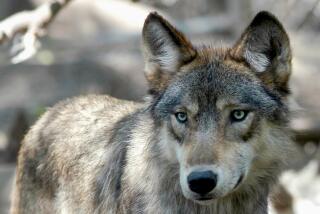Don’t Doom the Grizzly
- Share via
To the surprise and dismay of many conservationists and wildlife experts, some U.S. officials have concluded that the grizzly bear can make it on its own in northern Montana. That may be, but the U.S. Fish and Wildlife Service has a lot of proving to do before skeptics will accept the idea that it is safe to remove the grizzly from the threatened-species list.
The grizzly once populated the entire West, but its numbers fell to just a few hundred by the 1970s, and the bear was afforded refuge under the Rare and Endangered Species Act. Today there may be as many as 800 grizzly bears ranging the 5.7-million-acre Northern Continental Divide ecosystem that includes Glacier National Park and the Bob Marshall Wilderness Area in Montana. There may be as few as 500. The problem is that no one knows with any degree of certainty.
Assistant Supt. Alan O’Neill of Glacier National Park points to an even more telling statistic: The number of productive females in the entire region may be 80 or fewer. Grizzly females usually do not start to breed until they are 4 or 5 years old. Then they produce one pair of cubs about every third year. The fate of this relative handful of grizzly sows could determine the future of the bear in one of the few regions where it survives in the Lower 48 states.
Thus it is important that Interior Secretary Donald P. Hodel reverse or delay the recent proposal of the director of the U.S. Fish and Wildlife Service to remove the Northern Rocky Mountain grizzly from the federal government’s list of threatened species.
If the surprise proposal of Fish and Wildlife Service Director Frank Dunkle is implemented, management of the Northern Rocky Mountain bear herd would revert to the state of Montana, where there is considerable sentiment for having an open season so that the bear could be hunted by sportsmen. Now, individual grizzlies may be killed legally only if they are determined to be a threat to life or property. Also, removal of the grizzly from the list would open up hundreds of thousands of acres of bear habitat to oil and gas exploration and other forms of development.
Times staff writer Ronald B. Taylor has reported that Dunkle, himself a former Montana state wildlife official, said that he is making the proposal at the request of the state and on the basis of state officials’ population estimates. Fortunately, de-listing a species is a cumbersome process. Fish and Wildlife officials will have to demonstrate that the bear faces no danger of extinction. A new study of the bear’s numbers now is being conducted by a team of government agencies, including the Fish and Wildlife Service. Although the study may take more than three years to complete, no decision on the Rocky Mountain grizzly should be made until the results are in.
A rush to judgment on the supposed recovery of the grizzly might just doom it.
More to Read
Sign up for Essential California
The most important California stories and recommendations in your inbox every morning.
You may occasionally receive promotional content from the Los Angeles Times.













